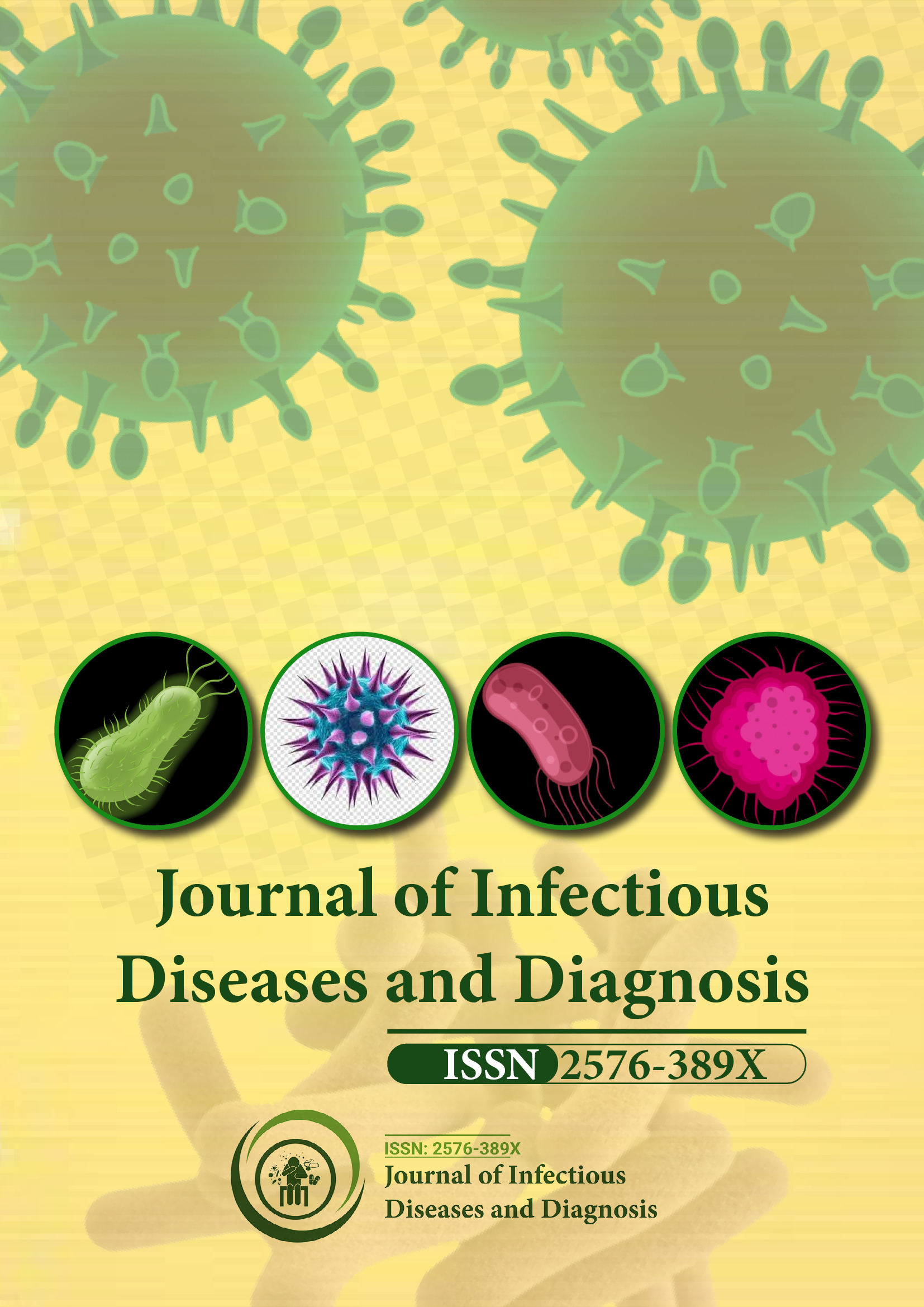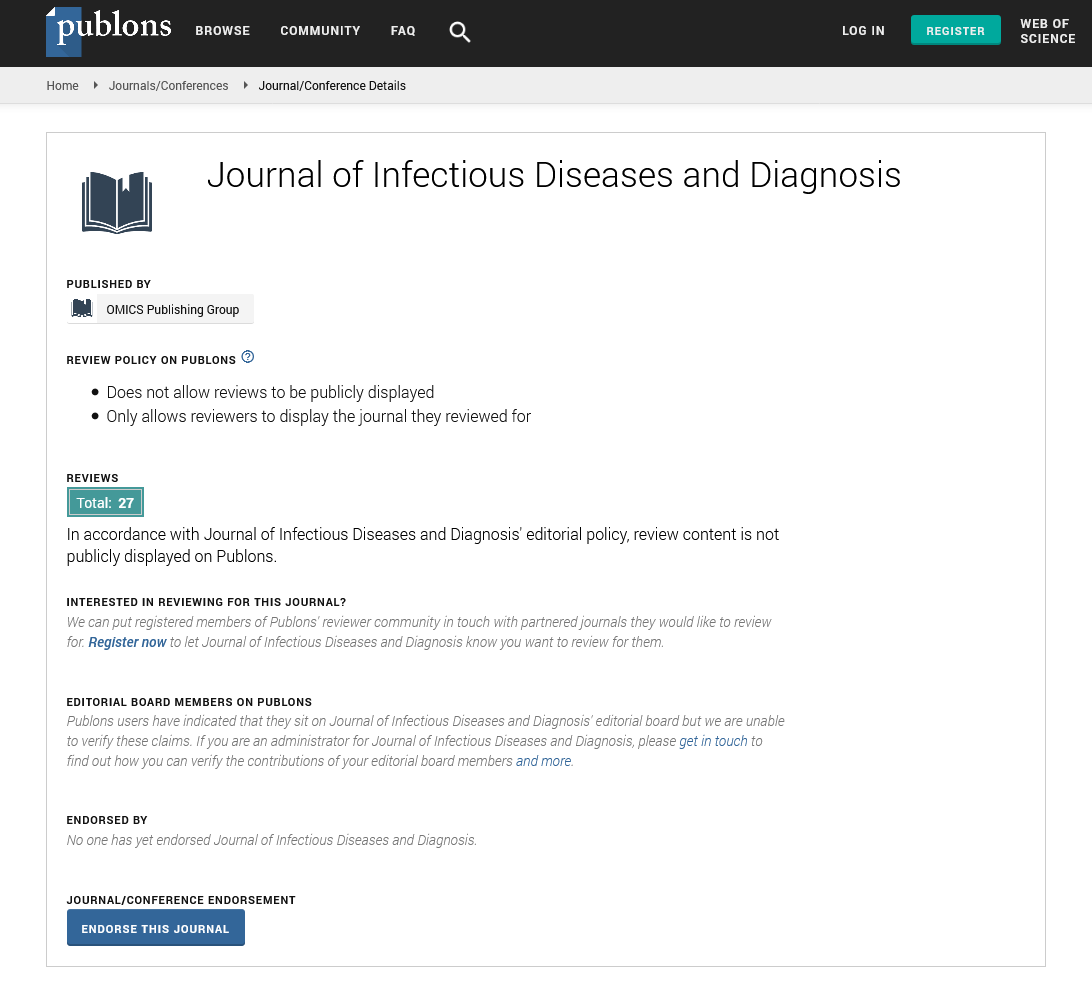Indexed In
- RefSeek
- Hamdard University
- EBSCO A-Z
- Publons
- Euro Pub
- Google Scholar
Useful Links
Share This Page
Journal Flyer

Open Access Journals
- Agri and Aquaculture
- Biochemistry
- Bioinformatics & Systems Biology
- Business & Management
- Chemistry
- Clinical Sciences
- Engineering
- Food & Nutrition
- General Science
- Genetics & Molecular Biology
- Immunology & Microbiology
- Medical Sciences
- Neuroscience & Psychology
- Nursing & Health Care
- Pharmaceutical Sciences
Opinion Article - (2025) Volume 10, Issue 4
Diagnosis of Pathogenic Microorganisms: Traditional Approaches and Emerging Molecular Techniques
Tamami Yehuda*Received: 30-Jun-2025, Manuscript No. JIDD-25-29513; Editor assigned: 03-Jul-2025, Pre QC No. JIDD-25-29513 (PQ); Reviewed: 17-Jul-2025, QC No. JIDD-25-29513; Revised: 24-Jul-2025, Manuscript No. JIDD-25-29513 (R); Published: 31-Jul-2025, DOI: 10.35248/2576-389X.25.10.346
Description
The accurate and timely diagnosis of pathogenic microorganisms remains central to effective clinical management, epidemiological control and public health planning. Infectious diseases caused by bacteria, viruses, fungi and parasites continue to pose significant challenges worldwide, demanding reliable diagnostic approaches. Traditional diagnostic methods have long served as the foundation of microbial identification. Microscopy, one of the oldest tools, remains a useful starting point for the rapid examination of samples. Gram staining, acid-fast staining and specialized dyes provide initial insights into the morphology and classification of microorganisms. However, microscopy alone often lacks specificity and sensitivity, making it most useful as a preliminary assessment rather than a definitive diagnostic tool.
Culture techniques have been widely regarded as the gold standard for microbial identification for decades. Bacterial cultures on selective or differential media allow microbiologists to isolate pure colonies for further analysis, while fungal cultures on specialized media aid in differentiating yeast and mold species. Culture remains indispensable in antibiotic susceptibility testing, guiding clinicians toward appropriate treatment regimens. However, culture-based methods are often time-consuming, sometimes requiring days to weeks, as seen in cases of Mycobacterium tuberculosis or slow-growing fungi. Additionally, some pathogens are difficult or impossible to culture under laboratory conditions, limiting the utility of this approach in certain scenarios.
Serological methods provide another important dimension to pathogen detection by targeting host immune responses. These tests, including Enzyme-Linked Immunosorbent Assays (ELISA), agglutination tests and immunofluorescence assays, detect pathogen-specific antigens or antibodies in patient samples. Serology is particularly useful in detecting infections where culture is challenging, such as viral diseases like HIV or hepatitis. Despite their wide application, serological tests can sometimes yield false positives or negatives, especially during early infection when antibodies have not yet developed or during late stages when antibody levels decline.
Molecular diagnostics have transformed the field by offering unprecedented accuracy and speed. Polymerase Chain Reaction (PCR) is among the most widely used molecular techniques, enabling the amplification and detection of pathogen-specific genetic sequences. PCR-based assays can detect minute quantities of microbial DNA or RNA, making them highly sensitive and specific. Real-time PCR, with its quantitative capabilities, further enhances diagnostic precision by allowing the measurement of pathogen load, which is particularly valuable in monitoring diseases such as HIV or COVID-19. Beyond PCR, Next-Generation Sequencing (NGS) has introduced a powerful tool for pathogen diagnosis and discovery. NGS allows simultaneous analysis of entire microbial genomes or metagenomes from complex samples, offering insights into pathogen diversity, drug resistance genes and emerging infectious agents. Although cost and technical complexity remain barriers, sequencing technologies are increasingly being integrated into clinical practice, particularly during outbreaks where rapid identification of novel pathogens is essential.
Rapid Diagnostic Tests (RDTs) have also gained prominence, particularly in resource-limited settings. These tests are designed for ease of use, requiring minimal laboratory infrastructure. Examples include lateral flow assays for malaria and rapid antigen tests for respiratory viruses. Although RDTs may sometimes sacrifice sensitivity compared to molecular methods, their portability, affordability and quick turnaround make them indispensable for large-scale screening and field applications.
Biosensor-based diagnostics represent a growing frontier in the field. These devices combine biological recognition elements, such as antibodies or nucleic acids, with physical transducers to detect pathogens or their components. Point-of-care biosensors have the potential to provide near-instantaneous results, reducing the gap between testing and treatment initiation. Such advancements are particularly beneficial in rural or underserved areas where access to centralized laboratories is limited.
In addition to human clinical applications, diagnosis of pathogenic microorganisms extends to agriculture, food safety and environmental monitoring. Pathogen detection in crops, for example, helps protect food security, while microbial testing in water supplies ensures public health. The same diagnostic platforms applied in hospitals are often adapted for use in these wider contexts, reinforcing their broader importance.
Despite significant advancements, challenges remain in diagnostic microbiology. False negatives due to sampling errors, contamination leading to false positives and the persistence of latent infections all complicate interpretation. Moreover, the cost and infrastructure requirements of advanced molecular tools can limit their accessibility in low- and middle-income regions. Ensuring that diagnostic innovations are affordable and scalable remains a pressing issue for global health.
Looking ahead, integration of Artificial Intelligence (AI) and machine learning into diagnostic workflows holds great potential. Algorithms trained on large datasets can improve interpretation of complex results, identify patterns in sequencing data and assist in outbreak prediction. Coupled with portable devices, AI-driven diagnostics could decentralize testing and make advanced technologies more widely available.
In conclusion, the diagnosis of pathogenic microorganisms has evolved from simple staining and culture techniques to highly sophisticated molecular and digital platforms. Each diagnostic approach contributes uniquely to the broader goal of detecting and managing infectious diseases. While traditional methods remain valuable for their simplicity and utility in resourcelimited settings, molecular and rapid techniques are shaping the future of clinical microbiology. Continued innovation, combined with efforts to ensure equitable access, will enhance our collective capacity to identify pathogens promptly and respond effectively to infectious disease threats.
Citation: Yehuda T (2025). Diagnosis of Pathogenic Microorganisms: Traditional Approaches and Emerging Molecular Techniques. J Infect Dis Diagn. 10:346.
Copyright: © 2025 Yehuda T. This is an open-access article distributed under the terms of the Creative Commons Attribution License, which permits unrestricted use, distribution and reproduction in any medium, provided the original author and source are credited.

